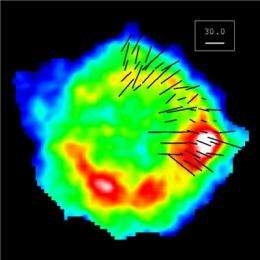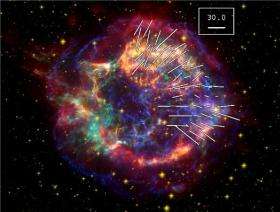A dust factory around a dead star

(PhysOrg.com) -- A team of astronomers, led by Loretta Dunne from the University of Nottingham, have found some very unusual stardust. In a paper to be published in Monthly Notices of the Royal Astronomical Society, Dr Dunne and her team find new evidence for the production of copious quantities of dust in the Cassiopeia A supernova remnant, the remains of a star that exploded about 300 years ago.
Interstellar dust is found throughout the cosmos. It is responsible for the dark patches seen in the Milky Way on a moonless night. It consists of carbon and silicate particles, about the size of those in cigarette smoke. The dust helps stars like the Sun to form and subsequently coagulates to form planets like Earth, and the cores of giant gas planets like Jupiter. It is found in great quantities in galaxies, even very early in the history of the Universe.
The origin of all this dust is, however, a mystery. Does it condense like snowflakes in the winds of red giant stars or is it produced in supernovae -the violent death-throes of massive stars? Supernovae are a good way to produce dust in a blink of the cosmic eye, as massive stars evolve relatively quickly, taking a few million years to reach their supernova stage. In contrast lower-mass stars like our Sun take billions of years to reach their dust-forming red giant phase. Despite many decades of research, astronomers have still not found conclusive evidence that supernovae can produce dust in the quantities required to account for the dust they see in the early Universe.

Using the SCUBA polarimeter on the James Clerk Maxwell Telescope in Hawaii, the scientists searched for a signal from dust grains spinning in the strong magnetic field of the supernova remnant. If the dust grains are slightly elongated (like little cigars) they tend to line up the same way and produce a polarised signal. When the polarimeter detector is rotated, the strength of the signal changes - much the same as if you look at the sky with polaroid sunglasses held at different angles.
The polarisation signal from the supernova dust is the strongest ever measured, anywhere in the Milky Way, so the supernova dust must be quite unusual. It emits more radiation per gram than regular interstellar dust and the alignment of the grains must be very orderly to produce such highly polarised emission. “It is like nothing we’ve ever seen” said Dr Dunne. “It could be that the extreme conditions inside the supernova remnant are responsible for the strong polarised signal, or it could be that the dust grains themselves are highly unusual”
Team member Professor Rob Ivison of the Science and Technology Facilities Council’s Astronomy Technology Centre in Edinburgh comments further. “It could be that the material we're seeing is in the form of iron needles - exotic, slender, metallic whiskers. If these grains are distributed throughout the Universe they may be re-radiating microwaves. This has major consequences for our understanding of the cosmic microwave background - one of the most important building blocks of the Big Bang model of our Universe”.
Alternatively, the grains could be a more pristine version of the dust found elsewhere in the Galaxy, with the same composition but able to produce more radiation due to the nuances of its 3-D structure. A final verdict requires further observations using the Herschel Space Observatory, set to be launched by the European Space Agency in April.
More information: L. Dunne, S. J. Maddox, L. Rudnick, T. A. Delaney, B. C. Matthews, C. M. Crowe, H. L. Gomez, S. A. Eales and S. Dye, "Cassiopeia A: dust factory revealed by submillimetre polarimetry", Monthly Notices of the Royal Astronomical Society, in press.
Provided by Royal Astronomical Society




















